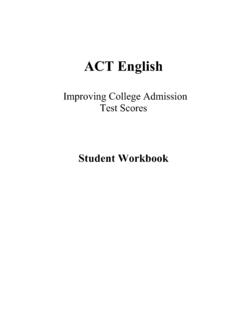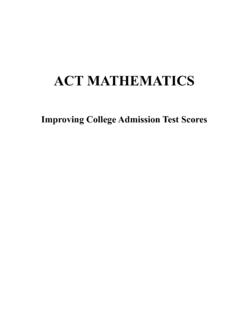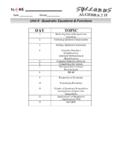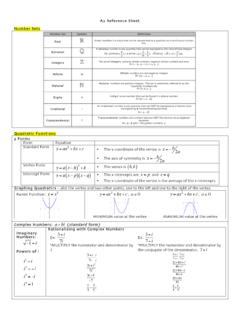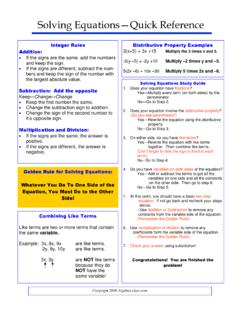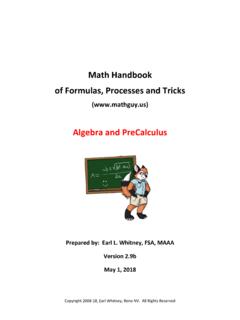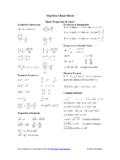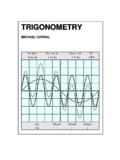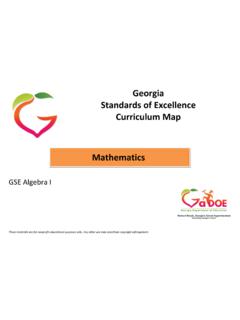Transcription of Improving College Admission Test Scores
1 ACT MATHEMATICS Improving College Admission Test Scores ii Contributing Writers Marie Haisan L. Ramadeen Matthew Miktus David Hoffman ACT is a registered trademark of ACT Inc. Copyright 2004 by Instructivision, Inc., revised 2006, 2009, 2011, 2014 ISBN 973-156749-774-8 Printed in Canada. All rights reserved. No part of the material protected by this copyright may be reproduced in any form or by any means, for commercial or educational use, without permission in writing from the copyright owner. Requests for permission to make copies of any part of the work should be mailed to Copyright Permissions, Instructivision, Inc., Box 2004, Pine Brook, NJ 07058. Instructivision, Inc., Box 2004, Pine Brook, NJ 07058 Telephone 973-575-9992 or 888-551-5144; fax 973-575-9134, website: iii TABLE OF CONTENTS Introduction iv Glossary of Terms vi Summary of Formulas, Properties, and Laws xvi Practice Test A 1 Practice Test B 16 Practice Test C 33 Pre Algebra Skill Builder One 51 Skill Builder Two 57 Skill Builder Three 65 Elementary Algebra Skill Builder Four 71 Skill Builder Five 77 Skill Builder Six 84 Intermediate Algebra Skill Builder Seven 88 Skill Builder Eight 97 Coordinate Geometry Skill Builder Nine 105 Skill Builder Ten 112 Plane Geometry Skill Builder Eleven 123 Skill Builder Twelve 133 Skill Builder Thirteen 145 Trigonometry Skill Builder Fourteen 158 Answer Forms 165 iv INTRODUCTION The American College Testing Program (ACT)
2 Is a comprehensive system of data collection, processing, and reporting designed to assist students in the transition from high school to College . The academic tests in English, mathe-matics, reading, and science reasoning emphasize reasoning and problem-solving skills. The test items represent scholastic tasks required to perform College level work. ACT questions are designed to measure a wide range of abilities and knowledge. Consequently, some of the items are difficult while others are fairly easy. A background of strong academic courses combined with a worthwhile review will enable you to meet this challenge successfully. The Mathematics Test The Mathematics Test is a 60-question, 60-minute examination that measures mathematics reasoning abilities.
3 The test focuses on the solution of practical quantitative problems that are encountered in high school and some College courses. The test uses a work-sample approach that measures mathematical skills in the context of simple and realistic situations. Each of the multiple-choice questions has five alternative responses. Examine the choices, and select the correct response. Three subscores based on six content areas are classified in the Mathematics Test (see chart, page v). The 60 test questions reflect an appropriate balance of content and skills (low, middle, and high difficulty) and range of performance. Because there is no penalty for guessing, answer every question. There are no trick questions; In some problems, you may have to go through a number of steps in order to find the correct answer.
4 In order to perform efficiently and accurately throughout the examination, you must understand and apply fundamental mathematical concepts. Spending too much time on any one item is unwise. On the average, spend about one minute on each question. Any remaining time should be spent in completing unanswered questions or reviewing previous work. How to Use the Mathematics Workbook This workbook consists of the introduction, a glossary of terms, formulas, three practice tests, skill builders, and additional questions for review. Glossary: The glossary defines commonly used mathematical expressions and many special and technical words. Formulas: Formulas that are commonly applied to mathematical problems are listed in a separate section. This section can be used as a convenient reference for formulas relating to geometric shapes and algebraic functions.
5 Practice Tests: There are three full-length practice tests. Under actual testing conditions, you are allowed 60 minutes for the entire test. The instructions should be followed carefully. Skill Builders: The skill builders describe and illustrate each of the content areas in the Mathematics Test. The skill builders are divided into sections, each of which relates to one of the principal categories covered in the test. Each skill builder consists of a series of examples, orientation exercises, practice exercises, and a practice test. The answers to the sample tests and the skill builder exercises and practice tests are not found in the Student Workbook. They are included in the Teacher Manual. How the ACT is Scored The raw score of 1 point for each correct answer will be converted to a scale score.
6 The scale on which ACT academic test Scores are reported is 1-36, with a mean (or average) of 18, based on a nationally representative sample of October-tested 12th grade students who plan to enter two-year or four-year colleges or universities. The scale for each subscore is 1-18, with a mean of 9. A guidance counselor will be glad to answer questions regarding the scoring process and the score reports. Math Strategies 1. Answer all questions. First do those problems with which you are most familiar and which seem the easiest to solve, and then answer those you find more difficult. 2. Practice pacing yourself. Try to solve most of the problems in less than one minute each. 3. Pay close attention to the information in each problem. Use the information that is important in solving the problem.
7 4. If you are making an educated guess, try to eliminate any choices that seem unreasonable. v 5. If the item asks for an equation, check to see if your equation can be transformed into one of the choices. 6. Always work in similar units of measure. 7. Sketch a diagram for reference when feasible. 8. Sometimes there is more than one way to solve a problem. Use the method that is most comfortable for you. 9. Use your estimation skills to make educated guesses. 10. Check your work. Items are classified according to six content areas. The categories and the approximate proportion of the test devoted to each are 1. Pre-Algebra. Items in this category are based on operations with whole numbers, decimals, fractions, and integers. They also may require the solution of linear equations in one variable.
8 2. Elementary Algebra. Items in this category are based on operations with algebraic expressions. The most advanced topic in this category is the solution of quadratic equations by factoring. 3. Intermediate Algebra. Items in this category are based on an understanding of the quadratic formula, rational and radical expressions, absolute value equations and inequalities, sequences and patterns, systems of equations, quadratic inequalities, functions, modeling, matrices, roots of polynomials, and complex numbers. 4. Coordinate Geometry. Items in this category are based on graphing and the relations between equations and graphs, including points, lines, polynomials, circles, and other curves; graphing inequalities; slope; parallel and perpendicular lines; distance; midpoints; and conics.
9 5. Plane Geometry. Items in this category are based on the properties and relations of plane figures. 6. Trigonometry. Items in this category are based on right triangle trigonometry, graphs of the trigonometric functions, and basic trigono-metric identities. ACT Assessment Mathematics Test 60 items, 60 minutes _____ Proportion Number Content Area o f Te s t of Items Pre-Algebra/ Elementary Algebra .40 24 Intermediate Algebra/ Coordinate Geometry .30 18 Plane Geometry/ Trigonometry . 30 18 _____ Total 60 Scores reported: Pre-Algebra/Elementary Algebra (24 items) Intermediate Algebra/Coordinate Geometry (18 items) Plane Geometry/Trigonometry (18 items) Total possible maximum raw test score (60 items) is 60. Because the formula for calculating the final score varies slightly each year, we have not included this information here.
10 Vi GLOSSARY OF TERMS ABSCISSA An ordered pair (x, y) specifying the distance of points from two perpendicular number lines (x and y-axis). , in (4, 6) the first number the x number (4) is called the abscissa. The second number the y number (6) is called the ordinate. ABSOLUTE VALUE The absolute value of a number x, written |x|, is the number without its sign; , |+8| = 8, |0| = 0, or |-4| = 4. On a number line it can be interpreted as the distance from zero, regardless of direction. ACUTE ANGLE An angle whose measure is less than 90 degrees. ACUTE TRIANGLE A triangle whose three angles each measure less than 90 degrees. ADDITIVE INVERSE The additive inverse of a number a is the number -a for which a + (-a) = 0. You can think of the additive inverse of a number as its opposite; , the additive inverse of -5 is +5 because (-5) + (+5) = 0.

